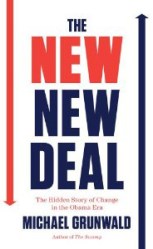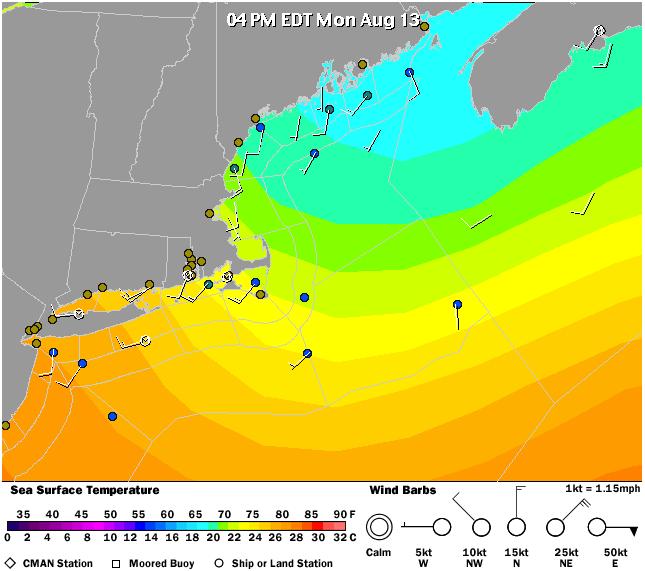
Michael Grunwald knows more about the stimulus than pretty much anyone else on the planet. (Photo by David Whitman.)
The Obama Era has been a disorienting experience for those of us attached to empirical reality. Press and popular narratives that have grown up around Obama and the legislation he’s signed bear only a tenuous relationship to facts.
Nowhere has the vertiginous disconnect been more in evidence than around the American Recovery and Reinvestment Act of 2009, known colloquially as “the stimulus bill.” Hashed out during the transition and passed almost immediately after Obama was inaugurated, it served as an early test of the GOP strategy of total opposition and real-time mythmaking. Republicans understand that Americans are suspicious of government spending in the abstract but supportive of most specific spending programs, so they aggressively pushed the line that the stimulus was a gigantic bucket of government pork, doled out to politically connected cronies, spent on silly and wasteful projects, failing in its stated goals. “The failed stimulus” became one of those annoying but successful right-wing verbal tics. The media mostly went along.
Very few people understand the scope or impact of the stimulus bill. The right remembers it as a useless cash dump, the left remembers it as an emergency measure that slowed and stopped the economic crash, but very few people have a good grasp on what was in it. In many people’s minds, it’s muddled together with the TARP “bailout.”
In fact, according to award-winning journalist Michael Grunwald, there were members of Congress (Democrats!) who confused the two bills. Grunwald realized the stimulus was a huge story that wasn’t being told, so he started digging, interviewing more than 400 people, sitting in on Cabinet meetings, and reading original documents. What he found was very close to the inverse of conventional wisdom: The stimulus was successful, well-administered, and virtually scandal-free. It contained the biggest clean energy bill in U.S. history alongside equally significant measures on infrastructure, education, science, and manufacturing. It was epochal, a burst of activist government of a scale not seen since FDR.
Thus the title of Grunwald’s new book: The New New Deal: The Hidden Story of Change in the Obama Era. I recently chatted with him on the phone about the book and the bill.
Q.  What were the big energy pieces in the stimulus?
What were the big energy pieces in the stimulus?
A. The energy stuff wasn’t just big, it was ginormous. It’s hard to get people twice as excited about $90 billion as they would be about $45 billion, or 10 times more than they would be about $9 billion, but even $9 billion would have been ginormous. Ten years earlier, [President] Clinton pushed a five-year, $6 billion clean energy bill that went nowhere; at the time it was seen as preposterous and unrealistic, and it was. And here, 10 years later, $90 billion in the guy’s first month in office. Plus it leveraged another $100 billion in private money.
Obama promised that he would double renewable power generation during his first term, and he did. In 2008, people had the sense that renewable energy was a tiny industry in the United States. What they forget is it was a tiny dead industry — because these wind and solar projects were essentially financed through tax credits, which required people with tax liability, and everybody had lost money, so nobody needed [the tax credits]. By changing those to a cash grant, it instantly unlocked this industry. Another thing that’s helped to create the wind and solar industry were advanced manufacturing tax credits, which were a gigantic deal. I think there were about 200 factories that got these credits. The classic example is Abengoa [Solar], which had shut down projects in Illinois, Texas, some other places. The day the stimulus passed, their chairman announced they were pouring $6 billion into U.S. projects.
For advanced biofuels, [the stimulus bill] created this $800 million program that essentially financed new refineries. And so you got the first 18 advanced biofuel refineries in the country just through that 1 percent of the clean energy funding. And there were some loan guarantees for that as well. There was also a whole geothermal technology program that went from about $20 million a year to $400 million. It’s leading right now to a real boom in geothermal production.
You can argue about this kind of green industrial policy, but it did what it was supposed to do. In 2008, I think 80 percent of the average U.S. wind turbine was made of imported parts. After the stimulus created all these factories — not just making the whole turbine, but making all of the 8,000 parts that go into a turbine — now it’s only 40 percent imported. That creates a constituency for wind power, and it also reduces the cost, because wind turbines are big honking pieces of equipment that you don’t want to be importing from abroad. It is true that a lot of these factories and a lot of these wind farms are owned by foreign companies, like Abengoa, but it really doesn’t matter whose corporate name is on the polo shirts. What matters is that these are American jobs and it’s producing green power in America.
Q. The loan guarantee program already existed, right? It just got a bunch of money?
A. Exactly. It financed the world’s largest wind farm, about a half dozen of the world’s largest solar arrays, the first two cellulosic biofuel refineries in the country.
The program was actually started in 2005 and the Bush administration didn’t do anything with it until his last month in office, when they tried to rush through a loan for this obscure solar manufacturer named Solyndra and almost got it done. That was the one sitting at the top of the pile when the Obama guys took over.
If you think of the loan guarantees as a bank giving a mortgage, what the stimulus did is let the government cover the mortgage insurance, which made it cheaper and easier for these companies to access this money. It wasn’t free money — the Obama administration did tough due diligence. On the Solyndra loan, they actually made Solyndra put in a larger down payment, if you want to use the mortgage analogy.
With all this clean energy stuff, look, a lot of these things aren’t gonna work. There are going to be Solyndras, some of these biofuels are going to turn out to be a bust. But if some of them work, you’re going to change the world.
And we’ve just been talking about renewables. The stimulus was also a huge deal for the smart grid, for electric vehicles —
Q. What did it do for the smart grid?
A. The smart grid was one of the signature legacy initiatives Obama [wanted]. At a Dec. 16 [2008] meeting in Chicago, they tried to decide what was going to be in the stimulus. And Obama said, let’s put $100 billion in and build a smart grid. And [energy and climate policy chief] Carol Browner, who had been waiting her whole life to have a smart grid, was sort of like, uhhh, Mr. President, you don’t just build a smart grid, there are all these NIMBY problems, you can’t just string wire across the country, it doesn’t really make sense to give everyone a smart meter, it doesn’t exactly work like that. Obama was really insistent, like, well, if we can’t do the whole smart grid, there’s gotta be something we can do. And he banged on people about it, during the whole transition, and they came up with some really innovative ideas. They ended up getting $11 billion for a smart grid. Turns out you can’t string wires all over the country, but you can get [the Bonneville Power Administration] and [the Western Area Power Administration] to start building some more high-voltage wires out to windy areas, and you can create these $4.5 billion grid-modernization grants.
This $4.5 billion really got utilities to do a lot of planning, but the unfortunate side effect is that the few that had actually started doing some smart-grid work, they pretty much stopped, because it was like, hey, now the feds might help pay for it. So it was really bad stimulus. And then the first round of grid money went mostly to smart meters — which is great, smart meters are good, but their first real impact is that they allow you to lay off all of your meter readers. So that wasn’t really terrific stimulus either.
But here’s how this $4.5 billion is starting to help. They used to check the transformers about once a year, but now because of the smart grid they’re checking them every second, and during the 2011 Orange Bowl they got this red alert that one of these transformers was about to blow — which is no big deal, they just route power around it, but if you’re only checking once every year instead of once every second, that’s the sort of thing that can black out a stadium. So of course nobody ever knows about it, and nobody ever says, Thank you, stimulus, for not blacking out the Orange Bowl. But this stuff does matter.
The smart grid is an example of something that really needed a jump-start and now it’s going.
Q. So we got a bunch of money for renewable energy, a bunch of money for smart grid …
A. The $90 billion includes high-speed rail too. And there was about $25 billion for energy efficiency, which as you know is the killer app of the energy world. There was energy efficiency for America’s largest steel plant, America’s largest hospital. There was $5.5 billion through the [General Services Administration] to green federal buildings and the federal fleet, which will save taxpayers huge money in the long run. And they had $5 billion for low-income weatherization, which is like gold. You’re solving every problem: You’re helping poor people, you’re putting guys with caulk guns to work, you’re saving energy, you’re saving money, you’re reducing our dependence [on foreign oil], etc. The program got off to this horribly slow start, though, partly because of dated rules and a bunch of other stupid regulations.
You could argue that there’s a lot more efficiency than I just mentioned because a lot of the basic infrastructure projects, the construction (there’s $5 billion for redoing public housing), they’re making it a lot greener.
Q. Because the stimulus bill was put together so fast, it’s hard to trace who wanted what. Who were the forces pushing for green energy?
A. It wasn’t all Obama. Obama had this green team on his transition team, led by Carol Browner. David Sandalow was on the team and he loves electric vehicles, so suddenly there’s $2 billion for batteries. And Dan Reicher was on the team, he loves geothermal, hot rocks, so that got $400 million. And then when it hit Congress, Congress was like, we have a few ideas. Harry Reid had some stuff he wanted about transmission, and he liked the hot rocks too, that’s big in Nevada.
Q. Republicans did the same thing to the word stimulus that they did to cap-and-trade — FUBARed it. Is it worth trying to rehabilitate the word?
A. In 2008, every presidential candidate, Democrat and Republican, had a stimulus package. And the biggest was by this guy named Mitt Romney. He testified in January ’09 about how we should do a stimulus package, with some philosophical differences from the way Obama did it, but basically supporting the idea of stimulus. I think it’s quite possible that if Mitt Romney became president you’d find, oh, suddenly Republicans like stimulus again.
Q. Do you see the politics of clean energy being any different post-stimulus than pre-stimulus?
A. They’re probably a little worse — in a kind of good way. In the past, the fossil-fuel industry’s attitude toward this stuff was, let’s just ignore it, it’s too insignificant to matter (except maybe on ethanol, on which the fossil-fuel guys were right). Now you’re really starting to see them come out swinging, which is a problem because these are the richest companies on the planet, but I think you can see it as a positive sign that these guys realize it’s now a force they have to take on that threatens their livelihood. I think solar is growing so fast that it could become a player.
Q. It seems like coverage of the stimulus bill was an Iraq-War-level failure on the media’s part.
A. There is a funny scene toward the end of the book (at least I think it’s funny; it’s a stimulus book, take your entertainment where you can). I’m talking to Joe Biden, and he’s giving me shit, like, “Ohh, you are the only one writing anything nice about the stimulus! I loved your articles, I took them to bed with me!”
If you know me personally, I’m more of a Debbie Downer than Little Mary Sunshine. I’m not the good news guy. But when I first tried to sell this story about how the stimulus is changing America to my bosses [at Time], their eyes glazed over. They thought I was crazy. I flew up to New York to try to convince them, and I told them I felt like I was some reporter back in 1938 telling his bosses about this amazing presidential initiative called the New Deal. They looked at me like I was like that blogger in The Newsroom who’s trying to sell a story about Bigfoot.



